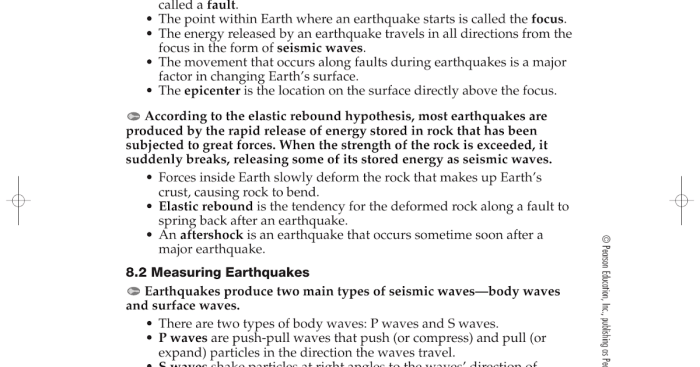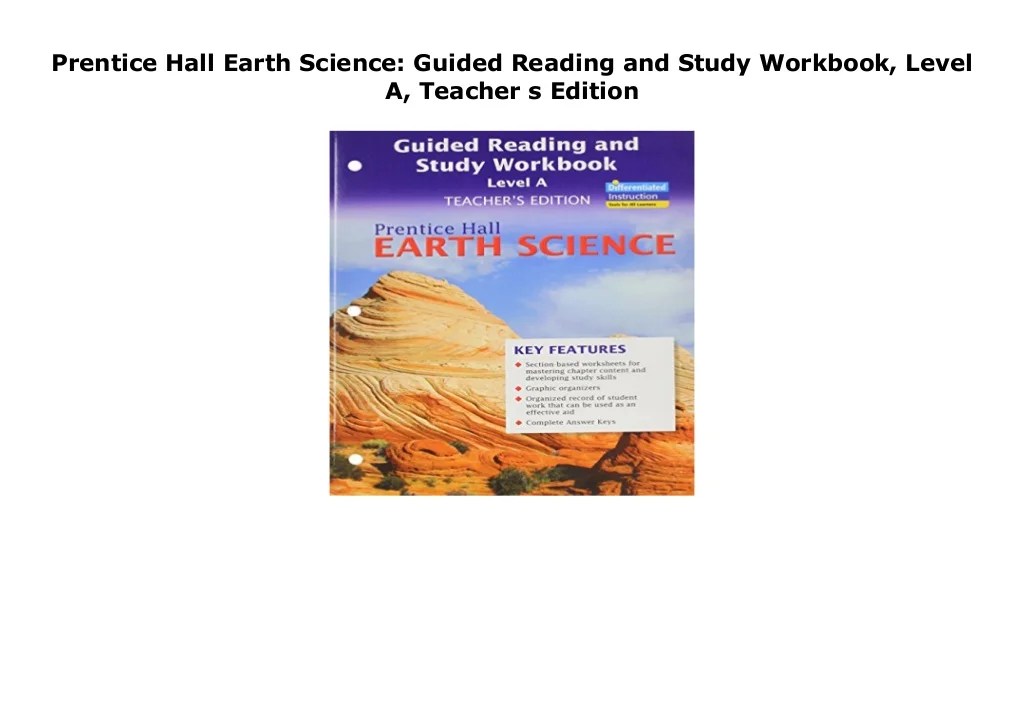Embark on a journey of scientific exploration with Earth Science Guided Reading and Study Workbook Answers, an invaluable resource designed to illuminate the complexities of our planet. Delve into the intricacies of Earth’s systems, from the towering mountains to the vast oceans, and unravel the mysteries that shape our world.
Through guided reading activities, study workbook solutions, and a wealth of additional resources, this comprehensive guide empowers students to grasp Earth science concepts with clarity and confidence. Uncover the secrets of plate tectonics, climate change, and the rock cycle, while fostering critical thinking and problem-solving skills.
1. Earth Science Concepts: Earth Science Guided Reading And Study Workbook Answers

Earth science is the study of the Earth’s systems and processes. It encompasses a wide range of disciplines, including geology, meteorology, oceanography, and astronomy. Earth scientists seek to understand the Earth’s structure, composition, and history, as well as the interactions between the Earth’s systems.
1.1 Earth’s Structure and Composition
- The Earth is composed of four main layers: the atmosphere, hydrosphere, lithosphere, and biosphere.
- The atmosphere is the layer of gases that surrounds the Earth.
- The hydrosphere is the layer of water that covers the Earth’s surface.
- The lithosphere is the layer of rock that forms the Earth’s crust.
- The biosphere is the layer of life that exists on Earth.
1.2 Plate Tectonics, Earth science guided reading and study workbook answers
Plate tectonics is the theory that the Earth’s lithosphere is divided into a number of tectonic plates that move around the Earth’s surface.
- There are three main types of plate boundaries: convergent boundaries, divergent boundaries, and transform boundaries.
- Convergent boundaries are where two plates collide.
- Divergent boundaries are where two plates move apart.
- Transform boundaries are where two plates slide past each other.
1.3 Earth’s Climate System
The Earth’s climate system is the complex interaction of the atmosphere, hydrosphere, lithosphere, and biosphere.
- The Earth’s climate is influenced by a number of factors, including the Sun’s energy, the Earth’s rotation, and the Earth’s atmosphere.
- Climate change is the long-term change in the Earth’s climate system.
- Climate change can be caused by natural factors, such as changes in the Sun’s energy output, or by human activities, such as the burning of fossil fuels.
1.4 The Rock Cycle
The rock cycle is the process by which rocks are created, destroyed, and recycled.
- The rock cycle involves the processes of weathering, erosion, deposition, and metamorphism.
- Weathering is the process by which rocks are broken down into smaller pieces.
- Erosion is the process by which rocks are transported from one place to another.
- Deposition is the process by which rocks are deposited in a new location.
- Metamorphism is the process by which rocks are changed by heat and pressure.
1.5 Types of Rocks
| Rock Type | Composition | Texture | Formation |
|---|---|---|---|
| Igneous | Formed from cooled magma or lava | Fine-grained, medium-grained, or coarse-grained | Intrusive (formed underground) or extrusive (formed on the surface) |
| Sedimentary | Formed from the accumulation and compaction of sediments | Clastic (composed of fragments of other rocks), chemical (formed from the precipitation of minerals from solution), or organic (formed from the remains of plants and animals) | Formed in water (aquatic) or on land (terrestrial) |
| Metamorphic | Formed from the alteration of existing rocks by heat, pressure, or chemical reactions | Foliated (with layers or bands) or non-foliated (without layers or bands) | Formed deep underground |
Frequently Asked Questions
What is the purpose of Earth Science Guided Reading and Study Workbook Answers?
Earth Science Guided Reading and Study Workbook Answers provides comprehensive solutions to the questions and exercises in the Earth science study workbook, offering clear explanations and supporting materials to enhance understanding.
How can guided reading activities improve student comprehension?
Guided reading activities focus on key concepts, use graphic organizers, and differentiate instruction to meet the needs of diverse learners, promoting active engagement and deeper understanding.
What types of additional resources are included?
Earth Science Guided Reading and Study Workbook Answers recommends websites, books, and videos to supplement learning, providing students with a range of resources to explore Earth science concepts in greater depth.

